The Parasound Halo JC 1 monoblocks had already created quite a buzz when
our Editor-in-Chief informed me that a bench-tested pair was available for review. As soon
as my schedule opened up, I drove to Redwood City to load the monsters into
my car.
I was certainly intrigued by reports that these guys were comparable to the
big Krell monoblocks at a much lower price. I had once owned an entry-level
Krell KSA-50S power amp, which I found extraordinary in the bass department,
huge of soundstage, amazingly three-dimensional, aggressive on top, recessed
to a major fault in the midrange, and unnaturally -monochromatically -
sweet. I loved much of what it did, but its lack of true timbre and warmth
drove me nuts. When gut-wrenching Shostakovich symphonies, Alban Berg's
gripping atonality, and heavy metal all sound equally sweet, something is
way off.
Part of my dissatisfaction with the Krell, to be sure, was due to my
associated components and cables, which were not in the same league as what
I use now. The only piece of equipment that remains from those days is the
Classé 6 preamp, which I only use with LPs.
I also have two friends who own maximally upgraded McCormack DNA-1s. I have also found these amps strong in bass
but lacking in midrange warmth and fullness. Power cables that darken the
top while augmenting midrange body and bass extension are perfect for such
amps. Would the Parasounds replicate any of these faults, I wondered, or
would their strengths simply blow me away?
Especially enticing was the notion of discovering what so much power
contributes to musical enjoyment. I don't think I'd previously gone much
beyond 225W at Casa Serinus. The dynamic realism afforded by 400W monoblocks
was something I anticipated with eagerness.
Background and Technical
The JC 1 is a statement design by John Curl and CTC Builders. John's
legendary designs have included the original Levinson JC-2, Denneson JC-80,
Vendetta Phono preamplifier, master recorders for Wilson Audio and Mobile
Fidelity, and the mixing consoles used in live concerts by The Grateful Dead
and at Switzerland's Montreux Jazz Festival.
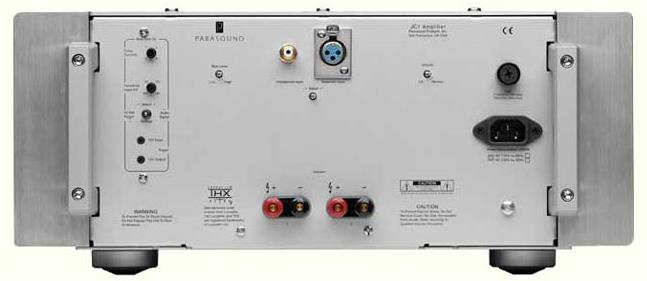
The heart of the JC 1's power supply is a 10 ampere continuous toroid
transformer encapsulated in an epoxy-filled steel canister (this is called a
"potted" transformer). Featuring
ultra-high bias Class A/AB operation, each JC 1 monoblock offers a two
position bias level adjustment, with lower bias producing less heat. One can
use either single-ended (Vampire Direct gold-plated OFC RCA) inputs or
balanced inputs (with discrete circuitry and Neutrik XLR connector). There are also dual heavy-duty 24k
gold-plated 5-way speaker binding posts
The JC 1 is direct coupled; there are neither capacitors nor inductors in
the signal path. Also featured are:
• Complementary discrete JFET input stage and MOSFET driver stage
• 18 beta-matched 15 amp, 60 MHz bipolar output transistors
• 1.9 kVA encapsulated toroid power transformer
• Independent power supplies for input, driver and output stages
• 18,000 µF filters for driver stage
• 132,000 µF Nichicon “Gold Tune” filters for output stage
• REL and Nichicon “Muse” capacitors
• Harris hyper-fast soft recovery diodes for all bridge rectifiers
• DC Servo and relay protection circuits
• Auto turn-on by 12v trigger or audio signal trigger
• Ground lift switch, adjustable turn-on delay
• 4u chassis with rear carry handles, rack mount kit included
• Premium detachable AWG 12 power cord with silver solder
• THX Ultra2 certified
Set-Up, Challenges, and Initial Impressions
These amps may be big, but each weighs less than my unwieldy Jadis Defy 7.
Anyone with a strong back should have no problem setting them up. Do be sure
to give them plenty of breathing space, however, because they generate lots
of heat in high bias mode. Our bedroom situated directly over the sound
system became noticeably warmer while these guys were cooking.
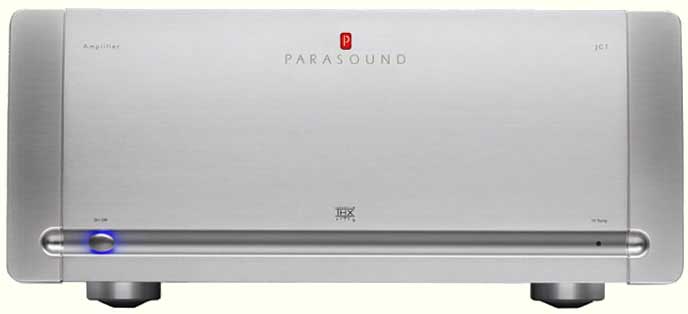
Having been assured by JJ that the amps were already broken-in, I plugged
them directly into the PS Audio P600 Power Plant and decided to let them
warm up overnight before taking my first listen. I knew warm-up would also help the cables settle in.
I could see that the amps' high power consumption was pushing the 600W
Power Plant to its limit. For awhile, the MultiWave II warning light blinked
yellow. But since wattage consumption seemed to decrease as the amps
continued to cook, and the light switched to green, I felt safe going to bed
with New Age music playing extremely low in the background.
Alas, I awoke to an absolutely cold system. The Power Plant had gone into
thermal overload and shut down, turning off all my components in the
process.
What a horror. Twelve members of the Bay Area Audiophile Society were about
to descend on Casa Serinus for a Stillpoints demo, and many were eager to
hear the Parasounds. Not only did the monoblocks themselves require warm-up,
but the Theta Gen. VIII DAC/preamp that fed them needed a good 72 hours of
warm-up to sound its best.
Needless to say, I was quite apprehensive. Anxiety increased over the notion
that I would be forced to plug the cold monoblocks directly into the wall,
without benefit of the Power Plant's clean power and MultiWave II P1 option.
When BAAS members took a brief listen, they were distinctly unimpressed.
“Good hi-fi” was one of the many disparaging remarks shared within minutes
of playing the first selection. My repeated interjections that the lack of
warm-up rendered such snap judgments of little value failed to make much of
an impact. Ah, audiophiles.
A good hour later, when we first listened to the Jadis, it trumped the
Parasound monoblocks in every respect. In fact, it sounded better and better
as the Theta began to cook and the Power Plant delivered its MultiWave P1
magic.
When I began the actual review process a few days later, I attempted to put
the Jadis and the Parasounds on an equal footing by comparing their sound
when all units were plugged directly into the wall. No matter which unit I
listened to, I found the sound distinctly gray and uninvolving. The black
background, clarity, detail, air, and range of color afforded by use of the
Power Plant were nowhere in evidence. Comparing one mediocre display with
another was not the way to write a reliable review.
(A criticism of the Power Plant is that because the smaller units can put
out only so much power, they tend to diminish dynamics on amplifiers that
draw large amounts of current. I find this limitation of minimal concern
with the Jadis because it draws only a bit more than 200W power except for
brief spurts during peaks. The Parasounds, on the other hand, draw so much
power that if I plug both into the Power Plant, even before it shuts down,
dynamics are noticeably compromised.)
It was necessary to address the dirty power issue as best I could. Calls to
several sources unfortunately failed to produce a long-term loan of a high
quality power conditioner or power regenerator.
Jim Volpatti of San Francisco's Silent Lucidity did bring over a Shunyata
Hydra Power Conditioner, but he was unable to leave it behind. The Hydra made a major
difference in sound quality, a difference that increased markedly when, at
the very end of our listening session, I took the Hydra off the floor and
suspended it on Ganymede ball bearing supports. I have now become a firm
believer in the importance of vibration isolation, and have put Ganymedes
under all my components including the speakers.
As you may have already read in my Nordost power cable review, I powered the
monoblocks with the superb Nordost Valhalla power cables. Unfortunately,
these had not fully broken-in at the time Jim brought the Hydra. So while I
temporarily had use of an excellent power conditioner, I was unable to hear
the JC 1s at their best. The dry sound we heard at the time, attributable to
inadequately broken-in power cables, is NOT an attribute of the JC 1s.
Happily, I was eventually able to borrow a prototype passive noise silencing
power strip from Jack Bybee. This four-outlet prototype is based on Jack's
new “Slipstream” technology. Plugging the now completely broken in Nordost
Valhalla power cables into Jack's prototype and using them to power the
monoblocks noticeably lowered the noise floor and improved the sound, albeit
not to the level afforded by either the Hydra or the seemingly unusable
Power Plant.
As explained in the technical section above, the Parasounds accommodate both
single-ended and balanced cables. It is easy to compare the sound of
single-ended cabling to balanced by flipping a simple toggle switch located
on the back of each monoblock. I was especially eager to listen through
balanced interconnects because the Theta Gen. VIII DAC/preamp, which
performs best in balanced mode, can only be operated in single-ended mode
when paired with the Jadis.
While I had Acoustic Zen balanced interconnects on hand, auditioning them on
a number of occasions has convinced me that their enviable transparency is
partly the product of a bright top paired with a weaker lower midrange and
bottom. As expected, listening to the monoblocks through them definitely
“lifted the veil” and supplied additional brilliance, but at the expense of
midrange fullness and bass slam.
While I was able to extrapolate how much better the JC 1s might sound with
balanced inputs, the friends I invited over to audition the monoblocks with
Acoustic Zen balanced interconnects greatly preferred the sound of my
reference pair of single-ended Nordost Valhallas. The sound may have been
grayer due to the JC 1's higher noise floor in single-ended mode, but there
was more there there with the Valhallas.
Clearly I needed a pair of balanced Nordost Valhalla interconnects in order
to fairly evaluate the JC 1s in balanced mode. I wish to express my eternal
gratitude to Joe Reynolds of Nordost for rushing me a set of Nordost
Valhalla balanced interconnects for this review.
Further Listening
I soon discovered that listening in single-ended mode activated a
long-standing ground loop hum in my system. I usually solve this problem by
using a cheater plug. The Parasounds provide a second possible solution: you
can float the ground by flipping a simple toggle switch on the back of each
monoblock.
I experimented both with cheater plugs and flipping the ground switch. Both myself and my friend Alan felt that something was lost when I
flipped the switch to floating. Impact and realism were ever so slightly
diminished. Cheater plugs are hardly a perfect solution, but in this case
they proved the lesser of two evils.
While in single-ended mode, I tried changing the bias from high to low. Low
bias will certainly save on electricity and produce less heat, but it
noticeably dims the sound. Unless you're suffering from inflated energy
bills or are temporarily using the monoblocks to play low, background music,
I suggest you play them in high bias mode.
To summarize, these amps benefit greatly from the finest power
conditioning/noise reduction one can offer; they sound best without switching the
ground switch to floating; and they deliver their most alive, open sound in high
bias mode.
My big discovery was just how much of an improvement the balanced inputs
offer over single-ended (RCA) inputs. Using Nordost Valhalla balanced interconnects
on both inputs, the difference was now huge. I heard lots more color
significantly more transparent sound, and a far more musical presentation. The difference
was not subtle.
Beyond Balanced
Regardless of which input I used, I was STUNNED by the JC 1's bass slam.
Bass on these amps was extraordinarily powerful, immediate, and under
impeccable control.
In one of my initial listening sessions, Jim Volpatti brought over his
commercial pressing of Patricia Barber's Modern Cool. The long percussion
solos on the first track (“Touch of Trash”) were stunning, absolutely
stunning. They sounded really good on the Jadis, but the Parasound's 400
Watts made for breathtaking dynamics and an even faster, more controlled
response. When the percussionists got going, the extra (natural) dynamics
and huge crescendos created a far more visceral experience.
If you want to understand what “fast” means in audiophile terms, listen to
these amps. The bass of the JC 1s is state of the art, riveting, jaw
dropping. It literally slams you in a most musical, timbre-true manner. With
these monoblocks, I could finally hear what Reference Recordings achieves
bass-wise on Rachmaninoff's Symphonic Dances.
Equally stunning is the clarity of the JC 1's highs. Initial thoughts that
they were overly bright vanished as the Nordost Valhalla power cables
completed their break--in process. The JC 1s highs do not possess the
gossamer-like, silken clarity of some tube equipment, but they are
unquestionably musical, brilliant, and true of timbre.
For comparison sake, Jim and I briefly listened to a pair of
Electrocompaniet AW 220s that list for over $5000. These output 220 Watts in
bridged mono. Their sound could hardly be farther apart from the Parasounds.
If the Parasounds knock you over, the Electrocompaniets leave you standing.
They have a significantly warmer midrange, a softer top, and bass best
described as slow to the punch. Through the Electrocompaniets, Patricia
Barber's percussionists began to sound like they had gotten high on helium
and lost all motivation to hit their instruments with force. Or had we
audiophiles taken drugs strong enough to make their drumsticks sound like
they were made of rubber?
If it's a “romantic” sound you're after, the Electrocompaniets may fill the
bill. They're certainly perfect for background listening. They sound like
the back of the hall, especially a hall without great
acoustics. The Parasounds, on the other hand, bring you right up front.
Nowhere to run, nowhere to hide. The good news is, with sound this terrific, why
would you want to hide?
Playing with Power
A day or two before I began to write this review I tried an experiment. I
knew the Power Plant couldn't handle both JC 1s for an extended length of
time. But what would happen if I plugged just one into the Power Plant?
No problem. The wattage readout in MultiWave II P1 mode fluctuated between
260 and 280 for the combination of transport, Theta, and single JC 1
monoblock. That left a good 300 Watt headroom for peak loads.
It seemed kind of crazy to listen with only one channel benefiting from the
Power Plant. But when I tried it, the transformation I heard was huge. A
remarkable clarity emerged, an additional silence, generous helping of air,
and a natural shininess that in many respects reminded me of the real thing
heard up close. All of a sudden, when listening to the Rachmaninoff, I could
hear the air conditioning in the Minnesota Orchestra's hall.
At least one contributor to a recent dialogue about the sound of digital
vs. analog suggested that CDs tend to tip the
balance toward the upper midrange and treble. All I can say is that if
you've ever heard Mahler's Symphony No. 8 (Symphony of a Thousand) from Row
K orchestra of Davies Symphony Hall, you know that the treble impact is such
that sustained listening at such levels could contribute to eardrum damage.
I never find myself thinking about the presence or absence of a mellow
midrange when sitting so close.
Farther back in Davies' orchestra section, where instruments begin to blend
one into the other, treble drops off, and the entire orchestra takes on a
resonant glow, I may focus on midrange warmth. But when I'm close to the
orchestra in such an acoustically excellent hall, my main attention is drawn
to the music's emotional and visceral impact.
Have you ever sat very close to chamber musicians during a performance? When I
first visited my cellist friend Elaine Kreston in her former high-ceilinged
Berkeley apartment and stood right next to her as she played, I was stunned
by how different her cello sounded than when heard from the middle of an
“intimate” concert hall. Her instrument had tremendous force and richness,
with a treble edge that is barely audible in larger settings. It took my
breath away.
Treble volume and presence drop dramatically over distance, while bass tends
to remain constant. This is why when the people across the street turn up
the volume on their system and blast pop music you hear the bass far more
than the treble. It is also, I believe, one of the reasons why treble sounds
as strong as it does on closely miked recordings, especially recordings
which position multiple mikes right over strings, cymbals, piccolos, and
other high-pitched instruments).
Even with only one channel benefiting from the Power Plant, the Parasounds'
treble glistened in a most arresting manner. Combined with their bass slam,
under even greater control as a result of clean power, the results were
gripping. I'm not sure the Parasounds would be my amplification of choice
when listening to intimate chamber music, a classical song recital with
piano accompaniment, a lute solo, or a guitar-strumming folk artist. But on
large scaled classical and popular music, music with drums and slam and
cymbals and dynamics and clatter and the all get-out, these amps are to die
for.
Shortly after this experiment, I again tried plugging both monoblocks into
the Power Plant and listening for a short period of time. The yellow light
flashed intermittently but nothing blew. Unfortunately, dynamics were so
severely compressed that the sound was most unsatisfactory. The power
conditioning used with these monoblocks must not in any way attenuate
dynamic response. If it does, you'll miss one of the Parasounds' great gifts.
Do the Parasounds provide all the liquidity, midrange warmth, and effortless
flow of the best tube gear? No. They are paramount on the attack, less so on
the decay. Such is the nature of solid state vs. tubes. Though I would never
label them recessed in the midrange, cold or mechanical, they are definitely
amps that draw attention to the extremes of the audible range. For listeners
who value most what the Parasounds can provide, they are a knockout.
On the Bench (JEJ)
In high-bias mode (used for all the tests), and using a
1 kHz input signal, THD was very, very low.

IMD was also low, using a 1 kHz and 1.5 kHz input
signal.
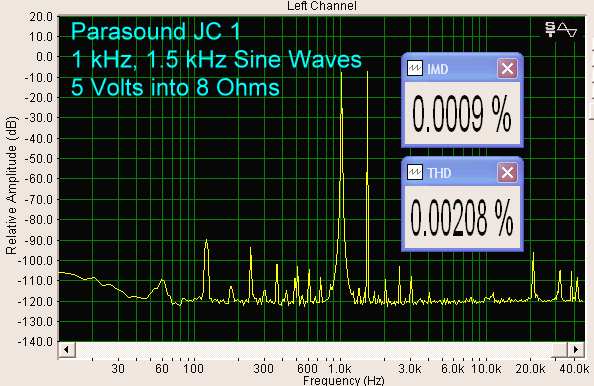
With 5 kHz and 6 kHz input, IMD was, again, very low.

At 10 kHz, THD was a bit higher than it was at lower
frequencies, but still quite low.
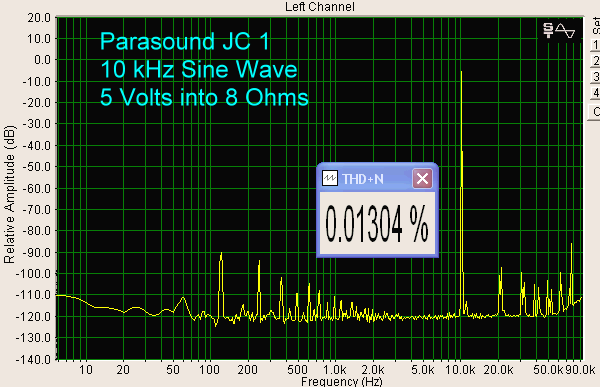
With 10 kHz and 11 kHz input, IMD was still extremely
low.
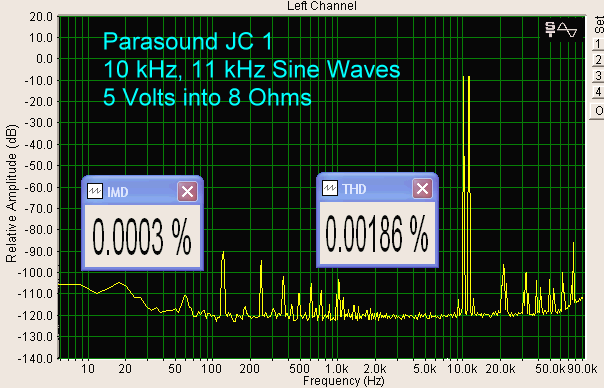
The measured frequency response was
± 0.5 dB 10 Hz - 50
kHz.

Conclusions
Listening to the Parasound Halo JC 1 monoblocks is a thrilling experience. I
could go on for days praising their bass slam, transparency, immediacy, and
brilliance. Ultimately, however, what I think of most when I listen to the
Parasounds is how much I'm enjoying the music. Facile distinctions between
tubes and solid state begin to lose their meaning when one can experience so
much realism for significantly less money than that charged for most
“statement” amplifiers. Of course, $6,000 is no chump change, but you can,
after all, spend six figures on a pair of amplifiers if you are so inclined.
Am I going to purchase the JC 1s? Though I hate to see them go, no. We've
just bought a house, and the process of selling one amp, replacing it with
monoblocks, getting another power conditioner and a third Nordost Valhalla
power cable for my transport (something I wouldn't want to be without after
hearing how it transforms the sound of any equipment it powers) is not
something I'm prepared to undertake right now. I will stick with the wonderful Jadis,
help pay the mortgage, and save my tears for those who think that nirvana
resides within a boom box.
Anyone who is in the market for better amplification, has good power
conditioning and enough power cables, and can afford to spend $6,000 would be
nuts not to give these monoblocks a home audition. In three words: they are
fabulous.
- Jason Victor Serinus -
REFERENCE SYSTEM
Digital Front End:
Sony 707ES transport modified by Alexander Peychev of APL Hi-Fi
Theta Gen VIII DAC/Preamp
Amplification:
Jadis Defy 7 Mk III or IV modified with a Siltech Silver Harness
Loudspeakers:
Talon Khorus X speakers MK. II (with latest modifications and Bybee filters)
Cabling:
Nordost Valhalla single-ended and balanced interconnects and balanced
digital interconnects
Nordost Valhalla bi-wired speaker cable
Acoustic Zen Silver Reference II balanced interconnects
Either Harmonic Tech Magic One, Nordost Silver Shadow, or Nirvana digital
interconnect for DVD-V
Power cables: Nordost Valhalla and Nordost Vishnu; Elrod EPS Signature 2 and
3 plus EPS 1, 2, and 3; WireWorld Silver Electra 5, PS Audio X-treme
Statement, Harmonic Tech, and AudioPrism SuperNatural S2.
Accessories:
PS Audio P600 Power Plant power synthesizer with MultiWave II
PS Audio Ultimate Outlet; PS Audio Power Ports
Michael Green Deluxe Ultrarack, Basic Racks and room treatment
Ganymede supports in main digital chain and under speakers
Michael Green Audiopoints, and Black Diamond Racing Cones elsewhere
Shakti stones for Amp and Theta
Stillpoints ERS EMI/RFI sheets on some components
Bedini Dual Beam Ultraclarifier
Audioprism CD Stoplight
Marigo as yet unreleased Signature Mat for use atop CDs
Ayre demagnetising CD and the original Sheffield/XLO degmagnetising and
break-in CD.












